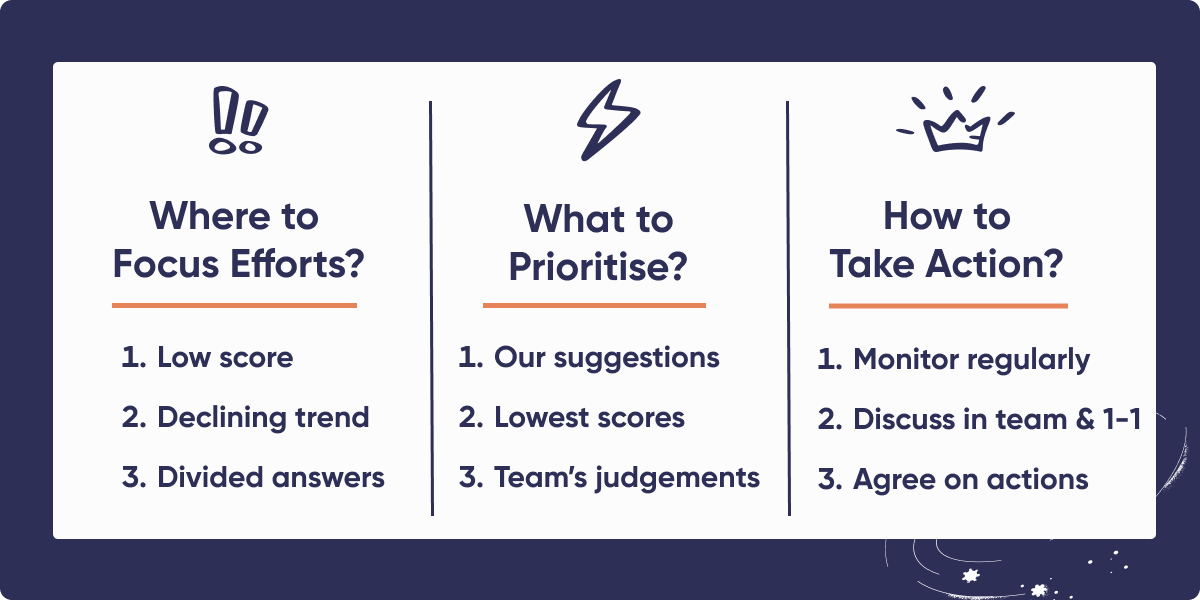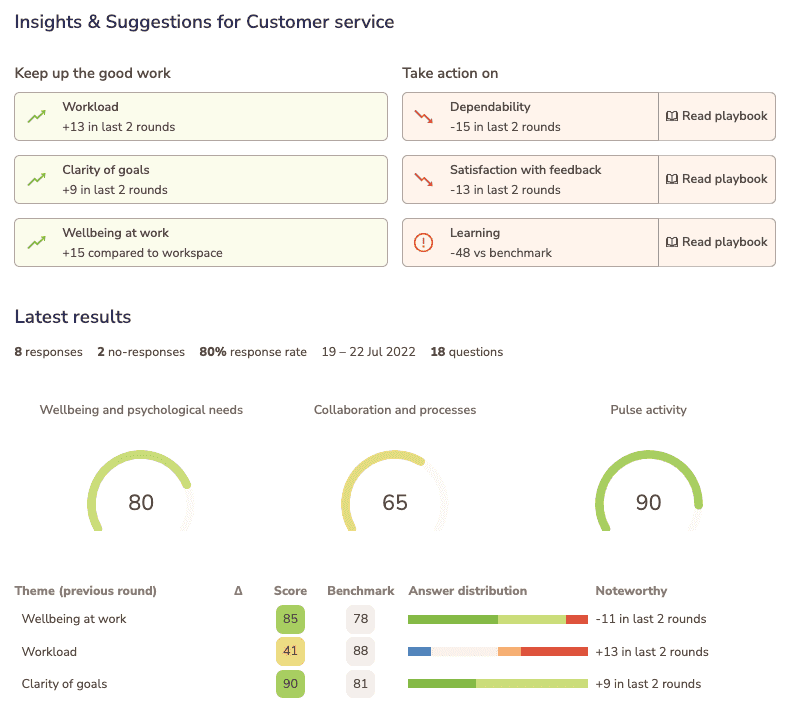Employee feedback is crucial for any people-oriented company. If you are already collecting feedback regularly via pulse surveys, keep it up! 💪🏻
Nevertheless, the hardest part is to take action on your data. Not knowing what exactly can be done can be very frustrating. This article presents the best practices for identifying your team’s biggest problems and addressing them.
“Where should I focus my efforts?”
Sometimes fluctuations in a certain KPI do not require any action at all. If it’s a one-time drop and your score is very close to the overall benchmark, you may want to avoid making rash moves and rather focus on the topics that indeed require improvement. Pay attention to these details in the data:
1. A low score compared to other KPIs, or to other teams in your company
If the other teams in your company are consistently doing much better with a certain theme, it may be a red flag. Probably this means that the issue is precisely in your team and is not an overall company trend.
Also, if your team scores in certain KPIs significantly worse than in others and the score is lower than the available benchmark, it is another reason to take a closer look. The case can be that your team members are not satisfied with one or two particular aspects at work and efforts should be directed on improving those areas.
2. A declining trend
The score may not seem alarming yet but you may still notice a slight drop week over week. In this case it is good to correct the course and address the issue early, before it becomes critical. “Has anything changed recently?” is the question to ask yourself and your team.
3. A wide spread in responses within the team
Does your score in a certain theme look pretty good because all team members are equally happy or because some are very happy and others are very upset? Looking just at the overall score is not enough. One should pay attention to the answer distribution as well.
A wide spread in answers indicates that individuals’ experiences differ greatly, and could be, for instance, a signal that individuals need more tailored support or personal attention.
“How do I understand what is a priority?”
In practice, understanding priorities is more challenging than it sounds. To help you, Teamspective automatically identifies focus areas and makes suggestions for each team. But what happens if too many areas need improvement? How does one understand which area is most urgent or important?
Focusing on too many initiatives at a time can lead to your efforts being unstructured. Teamspective’s pulse overview suggests a maximum of 3 areas for improvement at a time. Hence, it’s easy to start looking in the right direction.
One valid approach is to start with the theme that has the most room for improvement. Usually it takes time for the results of your actions to be visible, so rather take action earlier than later.
However, don’t neglect your and your team’s personal judgements. Discuss with the team what seems most crucial right now and what you would like to prioritize as a team. Success requires teamwork– in the end, it's all about people!
“What actions should I take to improve?”
If you are reading this, it means that you are ready to take action and improve, and at Teamspective we appreciate this mindset! Here are some useful habits to cultivate.
- Check results regularly and encourage responding
Step one is consistency. If you check results rarely, you get only a quick snapshot of your team’s feeling. We recommend reviewing pulse survey results at least 1-2 times a month, in order to keep a feel on the real-time trends. Teamspective’s results overview dashboard gets you updated in 5 minutes.
However, results may not be descriptive enough, if the response rate is low. Teamspective sends pulse surveys automatically to Slack (or MS Teams) and reminds later, if the survey is unanswered. However, it can still be valuable for leaders to remind their team members to reply to the pulse surveys e.g. in team meetings – especially during the first months after adoption.
Emphasise that responses help improve teamwork and wellbeing. To thank the team, you can simply use the Teamspective Praise feature, directly in Slack!
- Organise brainstorming sessions
Even if you have a strong idea of what your pulse results mean, show the results to your team and brainstorm together which focus areas are the most crucial. The best practice is to have such review sessions once a month.
Start by recognizing and celebrating the things that work – it’s important to say the positive out loud, even if it seems obvious. Continue by bringing up the topics that require attention and asking what issues your team would like to discuss. Pointing out the elephants in the room can feel uncomfortable. That is why we created Teamspective’s Pulse Playbooks for leaders.
Theme-specific Pulse Playbooks are also visible on your team’s Pulse results page. When you get comfortable with this routine, you can have a productive discussion on development priorities in as little as 15 minutes.
- Continue discussions on 1:1s or by organising a team retrospective
Following up on progress is just as important as agreeing on priorities. One-on-ones are great opportunities to discuss more personally how an employee is feeling about a certain theme.
To facilitate more analytical discussions as a group, we recommend organizing a team retrospective at least once a quarter. More tips for these coming up next.
- Agree on action points and owners for them
Many themes measured in pulse surveys are influenced by collaboration and interactions between people. Hence, in reviews and retros, active teamwork is usually both a means and an end.
It is important to facilitate discussions where people share experiences, understand other perspectives, and find better ways to work together and support each other. After your team gets used to the habit of analyzing and addressing focus areas, team members can take turns to hostreview sessions and retrospectives. It will help employees be more engaged and feel truly like a team.
Conclusion
We hope you found these tips useful. If you need help getting started with pulse surveys, reach out to us today.



